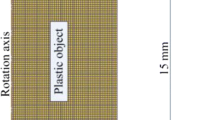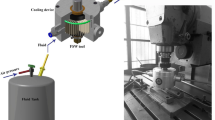Abstract
With the continuous augment of global oil demand and reserve volume, domed storage tanks are becoming increasingly widespread. The weak weld joint, designed on the top of the storage tank, will fail first in the pool fire. Therefore, it is of considerable significance to accurately obtain the change rules of the weld microstructure for studying the explosion of a domed oil storage tank, which can provide sufficient guarantee for the goods evacuation and personnel rescue. Dynamic recrystallization occurs in the failure process of a weld joint. Based on the cellular automaton method (CA method), the dynamic failure model for the weld joint was established and solved in this paper. The transient changes for stress, strain, temperature, and damage were calculated, and the grain size distribution and dynamic change rule of the weld joint were obtained. The tensile test was carried out to weak weld. A high-speed camera collected the fracture morphology of the weld joint during fracture. The simulation results were compared with the experimental results to verify the validity of the proposed model and analysis method.



























Similar content being viewed by others
References
L. Shi, J. Shuai and K. Xu, Fuzzy Fault Tree Assessment Based on Improved AHP for Fire and Explosion Accidents for Steel Oil Storage Tanks, J. Hazard Mater., 2014, 278, p 529–538. https://doi.org/10.1016/j.jhazmat.2014.06.034
J. Taveau, Explosion of Fixed Roof Atmospheric Storage Tanks, Part 1: Background and Review of Case Histories, Process Saf. Prog., 2011, 30(4), p 381–392. https://doi.org/10.1002/prs.10459
Z. Lu, D.V. Swenson and D.L. Fenton, Frangible Roof Joint Behavior of Cylindrical Oil Storage Tanks Designed to API 650 Rules, J. Press. Vessel Technol., 1996, 118(3), p 326–331. https://doi.org/10.1115/1.2842195
K. Spranghers, I. Vasilakos, D. Lecompte, H. Sol and J. Vantomme, Numerical simulation and experimental validation of the dynamic response of aluminum plates under free air explosions, Int. J. Impact Eng, 2013, 54, p 83–95. https://doi.org/10.1016/j.ijimpeng.2012.10.014
D. Wang, P. Zhang and L. Chen, Fuzzy Fault Tree Analysis for Fire and Explosion of Crude Oil Tanks, J. Loss Prev. Process Ind., 2013, 26(6), p 1390–1398.
W. Li, Q. Shao and J. Liang, Numerical Study on Oil Temperature Field During Long Storage in Large Floating Roof Tank, Int. J. Heat Mass Transf., 2019, 130, p 175–186. https://doi.org/10.1016/j.ijheatmasstransfer.2018.10.024
R. Luo, Q. Zheng, J.J. Zhu et al., Dynamic Recrystallization Behavior of Fe-20Cr-30Ni-0.6 Nb-2Al-Mo Alloy, Rare Metals, 2019, 38(2), p 181–188. https://doi.org/10.1007/s12598-016-0871-8
K.G.F. Janssens, Random grid, three-dimensional, space-time coupled cellular automata for the simulation of recrystallization and grain growth, Modell. Simul. Mater. Sci. Eng., 2003, 11(2), p 157. https://doi.org/10.1088/0965-0393/11/2/304
H.W. Hesselbarth and I.R. Göbel, Simulation of Recrystallization by Cellular Automata, Acta Metall. Mater., 1991, 39(9), p 2135–2143. https://doi.org/10.1016/0956-7151(91)90183-2
J.A. Spittle and S.G. Brown, A Cellular Automaton Model of Steady-State Columnar-Dendritic Growth in Binary Alloys, J. Mater. Sci., 1995, 30(16), p 3989–3994. https://doi.org/10.1007/BF00360698
R.L. Goetz and V. Seetharaman, Modeling Dynamic Recrystallization Using Cellular Automata, Scripta Mater., 1998, 38(3), p 405–413. https://doi.org/10.1016/S1359-6462(97)00500-9
H. Yan, Z. Liwen and N. Jing, Cellular Automata and its Application in Mesoscopic Simulation of Materials, Heat Treat. Met., 2005, 05, p 72–77.
W. Yu, E.J. Palmiere and S.P. Banks, Cellular Automata Modelling of Grain Coarsening During Reheating-II Abnormal Grain Growth, J. Univ. Sci. Technol. Beijing, 2005, 12(1), p 26–32.
W. Yu, E.J. Palmiere, S.P. Banks and J. Han, Cellular Automata Modelling of Austenite Grain Coarsening During Reheating-I, Normal Grain Coarse., 2004, 11(6), p 517–523. https://doi.org/10.2320/jinstmet.68.1086
Y. Hu, J. Xie, Z. Liu et al., CA Method with Machine Learning For Simulating the Grain And Pore Growth Of Aluminum Alloys, Comput. Mater. Sci., 2018, 142, p 244–254. https://doi.org/10.1016/j.commatsci.2017.09.059
W. Xu, R. Yuan, H. Wu et al., Study on the Dynamic Recrystallization Behavior of Ti-55 Titanium Alloy During Hot Compression Based on Cellular Automaton Model Method, Proc. Eng., 2017, 207, p 2119–2124. https://doi.org/10.1016/j.proeng.2017.10.1109
Y.X. Liu, Y.C. Lin and Y. Zhou, 2D Cellular Automaton Simulation of Hot Deformation Behavior in a Ni-Based Superalloy Under Varying Thermal-Mechanical Conditions, Mater. Sci. Eng., A, 2017, 691, p 88–99. https://doi.org/10.1016/j.msea.2017.03.039
L. Wang, G. Fang and L. Qian, Modeling of Dynamic Recrystallization of Magnesium Alloy Using Cellular Automata Considering Initial Topology of Grains, Mater. Sci. Eng., A, 2018, 711, p 268–283. https://doi.org/10.1016/j.msea.2017.11.024
L. Madej, M. Sitko, A. Legwand et al., Development and Evaluation of Data Transfer Protocols in the Fully Coupled Random Cellular Automata Finite Element Model of Dynamic Recrystallization, J. Comput. Sci., 2018, 26, p 66–77. https://doi.org/10.1016/j.jocs.2018.03.007
S.M. Bararpour, H.J. Aval and R. Jamaati, Cellular Automaton Modeling of Dynamic Recrystallization in Al-Mg Alloy Coating Fabricated Using the Friction Surfacing Process, Surf. Coat. Technol., 2021, 407, p 126784. https://doi.org/10.1016/j.surfcoat.2020.126784
N. Yazdipour, C.H.J. Davies and P.D. Hodgson, Microstructural Modeling of Dynamic Recrystallization Using Irregular Cellular Automata, Comput. Mater. Sci., 2009, 44(2), p 566–576. https://doi.org/10.1016/j.commatsci.2008.04.027
A. Laasraoui and J. Jonas, Prediction of Steel Flow Stresses at High Temperatures and Strain Rates, Metall. Trans. A, 1991, 22(7), p 1545–1558. https://doi.org/10.1007/bf02667368
J.J. Jonas, X. Quelennec, L. Jiang and É. Martin, The Avrami Kinetics of Dynamic Recrystallization, Acta Mater, 2009, 57(9), p 2748–2756. https://doi.org/10.1016/j.actamat.2009.02.033
X. Quelennec, E. Martin, L. Jiang and J.J. Jonas, Work Hardening and Kinetics of Dynamic Recrystallization in Hot Deformed Austenite, Proc. Natl. Acad. Sci, 2010, 109(41), p 2794–2802. https://doi.org/10.1073/pnas.1205742109
R. Ding and Z.X. Guo, Coupled Quantitative Simulation of Microstructural Evolution and Plastic Flow During Dynamic Recrystallization, Acta Mater, 2001, 49(16), p 3163–3175. https://doi.org/10.1016/s1359-6454(01)00233-6
R. Ding and Z.X. Guo, Microstructural Modelling of Dynamic Recrystallisation Using an Extended Cellular Automaton Approach, Comput. Mater. Sci., 2002, 23(1), p 209–218. https://doi.org/10.1016/s0927-0256(01)00211-7
Funding
This work was supported by Natural Science Foundation of Liaoning Province Guidance Program Project (2019ZD0277); Liaoning University of Science and Technology Innovation Team Building Project (601009830); Liaoning University Innovative Talent Support Program (20201020).
Author information
Authors and Affiliations
Corresponding author
Additional information
Publisher's Note
Springer Nature remains neutral with regard to jurisdictional claims in published maps and institutional affiliations.
Rights and permissions
About this article
Cite this article
Chang, L., Dacheng, Z., Xinxue, C. et al. Microstructure Simulation and Experiment for the Weak Weld Joint of a Domed Storage Tank during an Explosion Based on the Cellular Automaton Method. J. of Materi Eng and Perform 31, 8094–8112 (2022). https://doi.org/10.1007/s11665-022-06813-5
Received:
Revised:
Accepted:
Published:
Issue Date:
DOI: https://doi.org/10.1007/s11665-022-06813-5














